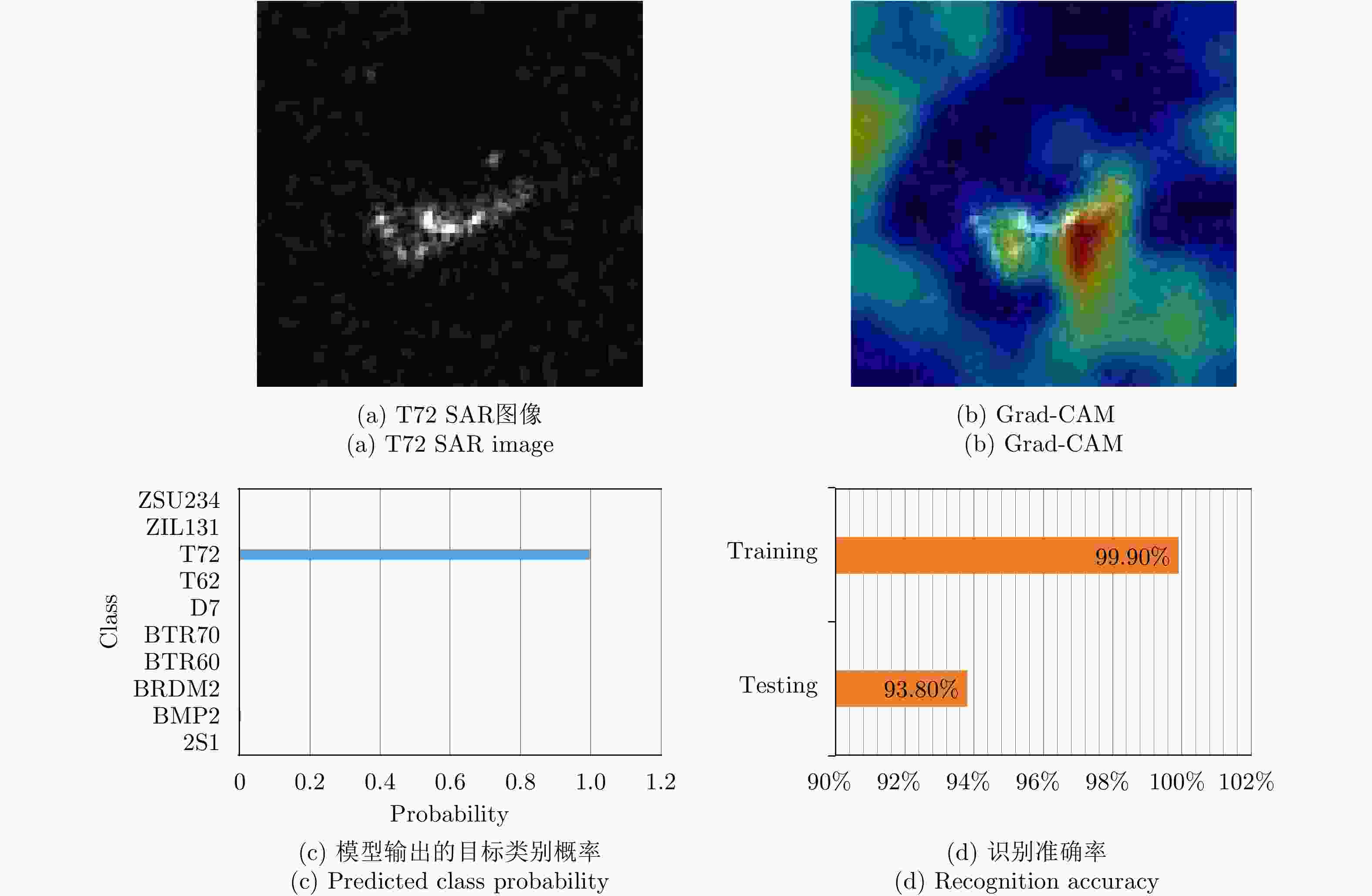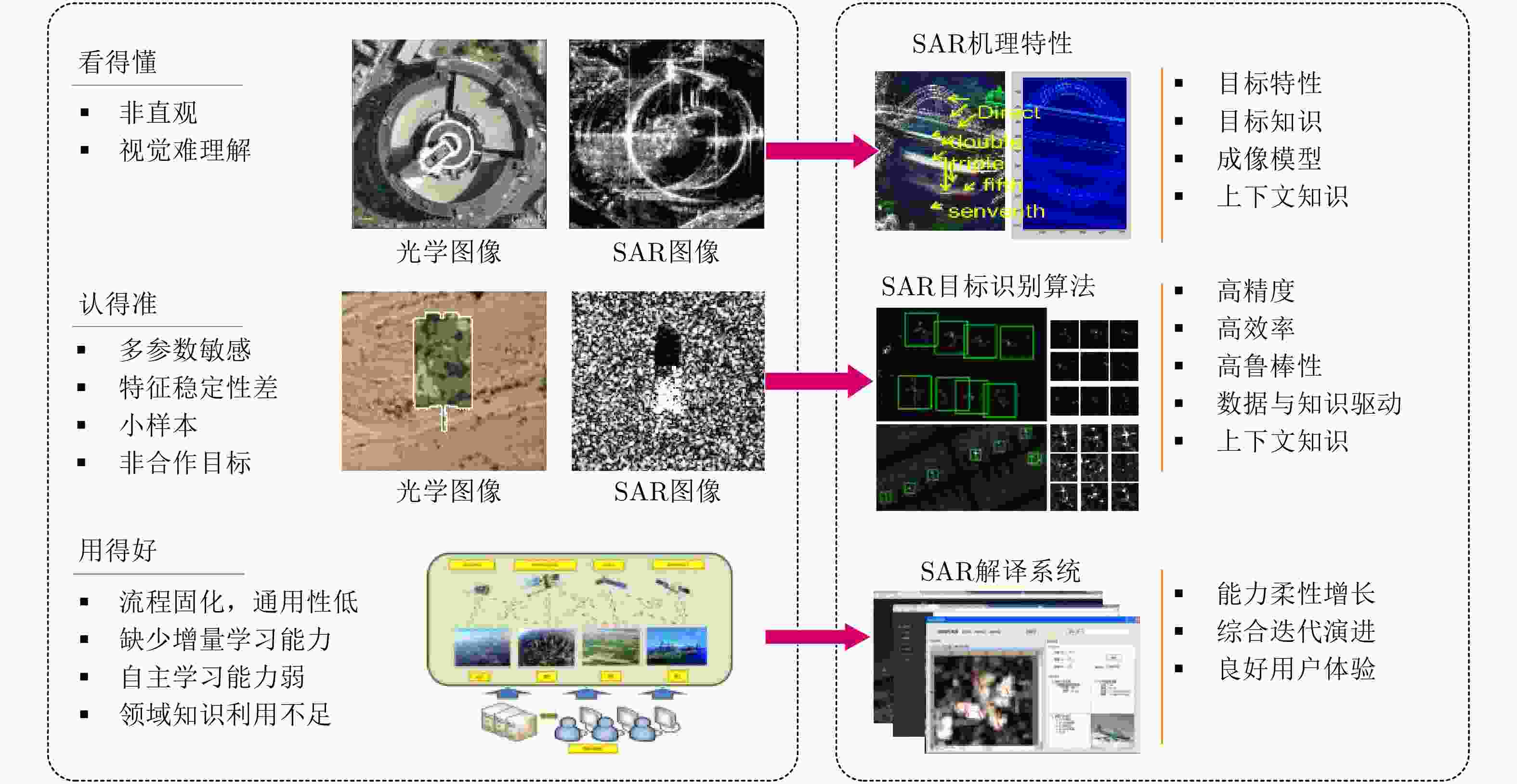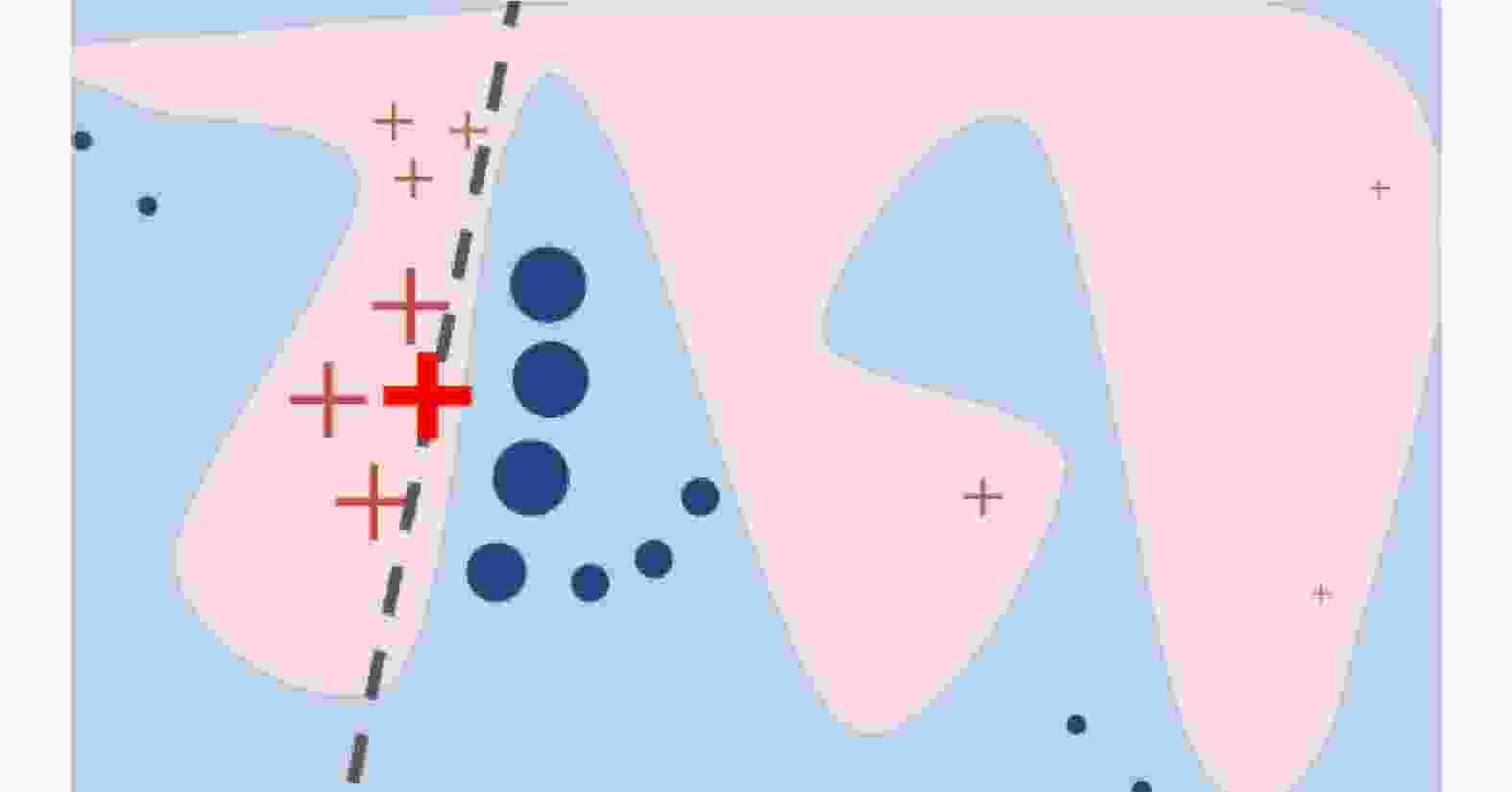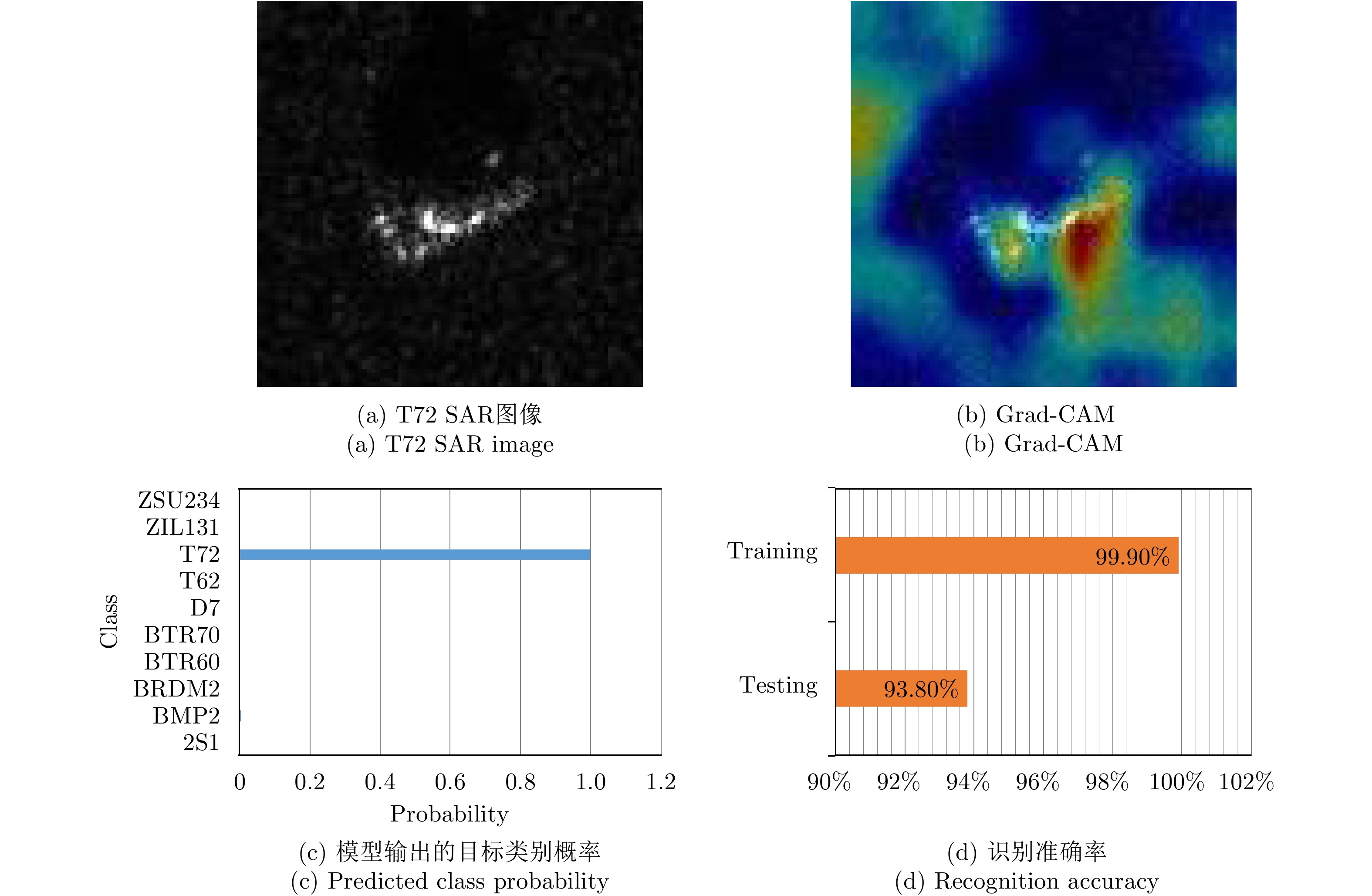-
摘要: 合成孔径雷达(SAR)图像目标识别是实现微波视觉的关键技术之一。尽管深度学习技术已被成功应用于解决SAR图像目标识别问题,并显著超越了传统方法的性能,但其内部工作机理不透明、解释性不足,成为制约SAR图像目标识别技术可靠和可信应用的瓶颈。深度学习的可解释性问题是目前人工智能领域的研究热点与难点,对于理解和信任模型决策至关重要。该文首先总结了当前SAR图像目标识别技术的研究进展和所面临的挑战,对目前深度学习可解释性问题的研究进展进行了梳理。在此基础上,从模型理解、模型诊断和模型改进等方面对SAR图像目标识别的可解释性问题进行了探讨。最后,以可解释性研究为切入点,从领域知识结合、人机协同和交互式学习等方面进一步讨论了未来突破SAR图像目标识别技术瓶颈有可能的方向。Abstract: SAR Automatic Target Recognition (ATR) is a key task in microwave remote sensing. Recently, Deep Neural Networks (DNNs) have shown promising results in SAR ATR. However, despite the success of DNNs, their underlying reasoning and decision mechanisms operate essentially like a black box and are unknown to users. This lack of transparency and explainability in SAR ATR pose a severe security risk and reduce the users’ trust in and the verifiability of the decision-making process. To address these challenges, in this paper, we argue that research on the explainability and interpretability of SAR ATR is necessary to enable development of interpretable SAR ATR models and algorithms, and thereby, improve the validity and transparency of AI-based SAR ATR systems. First, we present recent developments in SAR ATR, note current practical challenges, and make a plea for research to improve the explainability and interpretability of SAR ATR. Second, we review and summarize recent research in and practical applications of explainable machine learning and deep learning. Further, we discuss aspects of explainable SAR ATR with respect to model understanding, model diagnosis, and model improvement toward a better understanding of the internal representations and decision mechanisms. Moreover, we emphasize the need to exploit interpretable SAR feature learning and recognition models that integrate SAR physical characteristics and domain knowledge. Finally, we draw our conclusion and suggest future work for SAR ATR that combines data and knowledge-driven methods, human–computer cooperation, and interactive deep learning.
-
图 5 基于梯度系列方法的决策显著性①
Figure 5. Decision saliency of the Gradient-based methods
表 1 典型的可解释性方法
Table 1. Typical methods for explainablitiy
解释的对象 模型依赖(Model-specific) 模型无关(Model-agnostic) 解释模型
Explain model■激活最大化方法AM[43,44]
■概念激活矢量TCAV[45]■知识蒸馏(Knowledge distilling)[46]
■特征置换(Permutation)[47]解释样本
Explain sample■基于梯度的方法Grad[48], GuidedBP[49], IntegratedGrad[50], SmoothGrad[51]
■特征扰动分析Perturbation[52]
■层次相关传播LRP[53]
■类激活映射CAM[54], Grad-CAM[6]■基于局部代理模型的方法,如LIME[55]
■基于实例的方法,如Influence function[56],Critic样本方法[57]
■基于Shapley值的方法[58] -
[1] 金亚秋. 多模式遥感智能信息与目标识别: 微波视觉的物理智能[J]. 雷达学报, 2019, 8(6): 710–716. doi: 10.12000/JR19083JIN Yaqiu. Multimode remote sensing intelligent information and target recognition: Physical intelligence of microwave vision[J]. Journal of Radars, 2019, 8(6): 710–716. doi: 10.12000/JR19083 [2] KEYDEL E R, LEE S W, and MOORE J T. MSTAR extended operating conditions: A tutorial[C]. SPIE Volume 2757, Algorithms for Synthetic Aperture Radar Imagery III, Orlando, USA, 1996. doi: 10.1117/12.242059. [3] ZHAO Juanping, GUO Weiwei, ZHANG Zenghui, et al. A coupled convolutional neural network for small and densely clustered ship detection in SAR images[J]. Science China Information Sciences, 2019, 62(4): 42301. doi: 10.1007/s11432-017-9405-6 [4] 杜兰, 王兆成, 王燕, 等. 复杂场景下单通道SAR目标检测及鉴别研究进展综述[J]. 雷达学报, 2020, 9(1): 34–54. doi: 10.12000/JR19104DU Lan, WANG Zhaocheng, WANG Yan, et al. Survey of research progress on target detection and discrimination of single-channel SAR images for complex scenes[J]. Journal of Radars, 2020, 9(1): 34–54. doi: 10.12000/JR19104 [5] 徐丰, 王海鹏, 金亚秋. 深度学习在SAR目标识别与地物分类中的应用[J]. 雷达学报, 2017, 6(2): 136–148. doi: 10.12000/JR16130XU Feng, WANG Haipeng, and JIN Yaqiu. Deep learning as applied in SAR target recognition and terrain classification[J]. Journal of Radars, 2017, 6(2): 136–148. doi: 10.12000/JR16130 [6] SELVARAJU R R, COGSWELL M, DAS A, et al. Grad-CAM: Visual explanations from deep networks via gradient-based localization[J]. International Journal of Computer Vision, 2020, 128(2): 336–359. doi: 10.1007/s11263-019-01228-7 [7] GOODFELLOW I J, SHLENS J, and SZEGEDY C. Explaining and harnessing adversarial examples[C]. 2015 International Conference on Learning Representations, San Diego, USA, 2015. [8] 纪守领, 李进锋, 杜天宇, 等. 机器学习模型可解释性方法、应用与安全研究综述[J]. 计算机研究与发展, 2019, 56(10): 2071–2096. doi: 10.7544/issn1000-1239.2019.20190540JI Shouling, LI Jinfeng, DU Tianyu, et al. Survey on techniques, applications and security of machine learning interpretability[J]. Journal of Computer Research and Development, 2019, 56(10): 2071–2096. doi: 10.7544/issn1000-1239.2019.20190540 [9] 吴飞, 廖彬兵, 韩亚洪. 深度学习的可解释性[J]. 航空兵器, 2019, 26(1): 39–46. doi: 10.12132/ISSN.1673-5048.2018.0065WU Fei, LIAO Binbing, and HAN Yahong. Interpretability for deep learning[J]. Aero Weaponry, 2019, 26(1): 39–46. doi: 10.12132/ISSN.1673-5048.2018.0065 [10] GUIDOTTI R, MONREALE A, RUGGIERI S, et al. A survey of methods for explaining black box models[J]. ACM Computing Surveys, 2018, 51(5): 93. doi: 10.1145/3236009 [11] NOVAK L M, OWIRKA G J, and NETISHEN C M. Performance of a high-resolution polarimetric SAR automatic target recognition system[J]. The Lincoln Laboratory Journal, 1993, 6(1): 11–23. [12] GAO Gui. Statistical modeling of SAR images: A survey[J]. Sensors, 2010, 10(1): 775–795. doi: 10.3390/s100100775 [13] 高贵. SAR图像统计建模研究综述[J]. 信号处理, 2009, 25(8): 1270–1278. doi: 10.3969/j.issn.1003-0530.2009.08.019GAO Gui. Review on the statistical modeling of SAR images[J]. Signal Processing, 2009, 25(8): 1270–1278. doi: 10.3969/j.issn.1003-0530.2009.08.019 [14] 郭炜炜. SAR图像目标分割与特征提取[D]. [硕士论文], 国防科学技术大学, 2007: 28–35.GUO Weiwei. SAR image target segmentation and feature extraction[D]. [Master dissertation], National University of Defense Technology, 2007: 28–35. [15] HUAN Ruohong and YANG Ruliang. SAR target recognition based on MRF and gabor wavelet feature extraction[C]. 2008 IEEE International Geoscience and Remote Sensing Symposium, Boston, USA, 2008: II-907–II-910. doi: 10.1109/igarss.2008.4779142. [16] PAPSON S and NARAYANAN R M. Classification via the shadow region in SAR imagery[J]. IEEE Transactions on Aerospace and Electronic Systems, 2012, 48(2): 969–980. doi: 10.1109/taes.2012.6178042 [17] CASASENT D and CHANG W T. Correlation synthetic discriminant functions[J]. Applied Optics, 1986, 25(14): 2343–2350. doi: 10.1364/ao.25.002343 [18] ZHAO Q and PRINCIPE J C. Support vector machines for SAR automatic target recognition[J]. IEEE Transactions on Aerospace and Electronic Systems, 2001, 37(2): 643–654. doi: 10.1109/7.937475 [19] SUN Yijun, LIU Zhipeng, TODOROVIC S, et al. Adaptive boosting for SAR automatic target recognition[J]. IEEE Transactions on Aerospace and Electronic Systems, 2007, 43(1): 112–125. doi: 10.1109/taes.2007.357120 [20] SUN Yongguang, DU Lan, WANG Yan, et al. SAR automatic target recognition based on dictionary learning and joint dynamic sparse representation[J]. IEEE Geoscience and Remote Sensing Letters, 2016, 13(12): 1777–1781. doi: 10.1109/lgrs.2016.2608578 [21] POTTER L C and MOSES R L. Attributed scattering centers for SAR ATR[J]. IEEE Transactions on Image Processing, 1997, 6(1): 79–91. doi: 10.1109/83.552098 [22] 计科峰, 匡纲要, 粟毅, 等. 基于SAR图像的目标散射中心特征提取方法研究[J]. 国防科技大学学报, 2003, 25(1): 45–50. doi: 10.3969/j.issn.1001-2486.2003.01.010JI Kefeng, KUANG Gangyao, SU Yi, et al. Research on the extracting method of the scattering center feature from SAR imagery[J]. Journal of National University of Defense Technology, 2003, 25(1): 45–50. doi: 10.3969/j.issn.1001-2486.2003.01.010 [23] 丁柏圆, 文贡坚, 余连生, 等. 属性散射中心匹配及其在SAR目标识别中的应用[J]. 雷达学报, 2017, 6(2): 157–166. doi: 10.12000/JR16104DING Baiyuan, WEN Gongjian, YU Liansheng, et al. Matching of attributed scattering center and its application to synthetic aperture radar automatic target recognition[J]. Journal of Radars, 2017, 6(2): 157–166. doi: 10.12000/JR16104 [24] JONES III G and BHANU B. Recognizing articulated objects in SAR images[J]. Pattern Recognition, 2001, 34(2): 469–485. doi: 10.1016/s0031-3203(99)00218-6 [25] MAO Xiaojiao, SHEN Chunhua, and YANG Yubin. Image restoration using very deep convolutional encoder-decoder networks with symmetric skip connections[C]. The 30th International Conference on Neural Information Processing Systems, Barcelona, Spain, 2016: 2810–2818. [26] DONG Chao, LOY C C, HE Kaiming, et al. Image super-resolution using deep convolutional networks[J]. IEEE Transactions on Pattern Analysis and Machine Intelligence, 2016, 38(2): 295–307. doi: 10.1109/tpami.2015.2439281 [27] LIU Li, OUYANG Wanli, WANG Xiaogang, et al. Deep learning for generic object detection: A survey[J]. International Journal of Computer Vision, 2020, 128(2): 261–318. doi: 10.1007/s11263-019-01247-4 [28] HE Kaiming, ZHANG Xiangyu, REN Shaoqing, et al. Deep residual learning for image recognition[C]. 2016 IEEE Conference on Computer Vision and Pattern Recognition (CVPR), Las Vegas, USA, 2016: 770–778. [29] CHEN L C, PAPANDREOU G, KOKKINOS I, et al. DeepLab: Semantic image segmentation with deep convolutional nets, atrous convolution, and fully connected CRFs[J]. IEEE Transactions on Pattern Analysis and Machine Intelligence, 2018, 40(4): 834–848. doi: 10.1109/tpami.2017.2699184 [30] CHEN Sizhe, WANG Haipeng, XU Feng, et al. Target classification using the deep convolutional networks for sar images[J]. IEEE Transactions on Geoscience and Remote Sensing, 2016, 54(8): 4806–4817. doi: 10.1109/tgrs.2016.2551720 [31] 潘宗序, 安全智, 张冰尘. 基于深度学习的雷达图像目标识别研究进展[J]. 中国科学: 信息科学, 2019, 49(12): 1626–1639. doi: 10.1360/SSI-2019-0093PAN Zongxu, AN Quanzhi, and ZHANG Bingchen. Progress of deep learning-based target recognition in radar images[J]. Scientia Sinica Informationis, 2019, 49(12): 1626–1639. doi: 10.1360/SSI-2019-0093 [32] 贺丰收, 何友, 刘准钆, 等. 卷积神经网络在雷达自动目标识别中的研究进展[J]. 电子与信息学报, 2020, 42(1): 119–131. doi: 10.11999/JEIT180899HE Fengshou, HE You, LIU Zhunga, et al. Research and development on applications of convolutional neural networks of radar automatic target recognition[J]. Journal of Electronics and Information Technology, 2020, 42(1): 119–131. doi: 10.11999/JEIT180899 [33] ZHAO Juanping, ZHANG Zenghui, YU Wenxian, et al. A cascade coupled convolutional neural network guided visual attention method for ship detection from SAR images[J]. IEEE Access, 2018, 6: 50693–50708. doi: 10.1109/access.2018.2869289 [34] 陈慧元, 刘泽宇, 郭炜炜, 等. 基于级联卷积神经网络的大场景遥感图像舰船目标快速检测方法[J]. 雷达学报, 2019, 8(3): 413–424. doi: 10.12000/JR19041CHEN Huiyuan, LIU Zeyu, GUO Weiwei, et al. Fast detection of ship targets for large-scale remote sensing image based on a cascade convolutional neural network[J]. Journal of Radars, 2019, 8(3): 413–424. doi: 10.12000/JR19041 [35] WAGNER S. Combination of convolutional feature extraction and support vector machines for radar ATR[C]. The 17th International Conference on Information Fusion (FUSION), Salamanca, Spain, 2014: 1–6. [36] WAGNER S A. SAR ATR by a combination of convolutional neural network and support vector machines[J]. IEEE Transactions on Aerospace and Electronic Systems, 2016, 52(6): 2861–2872. doi: 10.1109/taes.2016.160061 [37] HUANG Zhongling, PAN Zongxu, and LEI Bin. What, where, and how to transfer in SAR target recognition based on deep CNNs[J]. IEEE Transactions on Geoscience and Remote Sensing, 2020, 58(4): 2324–2336. doi: 10.1109/tgrs.2019.2947634 [38] 赵娟萍, 郭炜炜, 柳彬, 等. 基于概率转移卷积神经网络的含噪标记SAR图像分类[J]. 雷达学报, 2017, 6(5): 514–523. doi: 10.12000/JR16140ZHAO Juanping, GUO Weiwei, LIU Bin, et al. Convolutional neural network-based sar image classification with noisy labels[J]. Journal of Radars, 2017, 6(5): 514–523. doi: 10.12000/JR16140 [39] GUNNING D. EXplainable Artificial Intelligence (XAI)[R]. DARPA/I2O, 2017. [40] ADADI A and BERRADA M. Peeking inside the black-box: A survey on EXplainable Artificial Intelligence (XAI)[J]. IEEE Access, 2018, 6: 52138–52160. doi: 10.1109/access.2018.2870052 [41] LIPTON Z C. The mythos of model interpretability[J]. Communications of the ACM, 2018, 61(10): 36–43. doi: 10.1145/3233231 [42] ZHANG Quanshi and ZHU Songchun. Visual interpretability for deep learning: A survey[J]. Frontiers of Information Technology & Electronic Engineering, 2018, 19(1): 27–39. doi: 10.1631/fitee.1700808 [43] MAHENDRAN A and VEDALDI A. Visualizing deep convolutional neural networks using natural pre-images[J]. International Journal of Computer Vision, 2016, 120(3): 233–255. doi: 10.1007/s11263-016-0911-8 [44] NGUYEN A, CLUNE J, BENGIO Y, et al. Plug & play generative networks: Conditional iterative generation of images in latent space[J]. arXiv: 1612.00005, 2016. [45] KIM B, WATTENBERG M, GILMER J, et al. Interpretability beyond feature attribution: Quantitative Testing with Concept Activation Vectors (TCAV)[J]. arXiv: 1711.11279, 2017. [46] FROSST N and HINTON G. Distilling a neural network into a soft decision tree[J]. arXiv: 1711.09784, 2017. [47] ALTMANN A, TOLOŞI L, SANDER O, et al. Permutation importance: A corrected feature importance measure[J]. Bioinformatics, 2010, 26(10): 1340–1347. doi: 10.1093/bioinformatics/btq134 [48] SIMONYAN K, VEDALDI A, and ZISSERMAN A. Deep inside convolutional networks: Visualising image classification models and saliency maps[J]. arXiv: 1312.6034, 2013. [49] SPRINGENBERG J T, DOSOVITSKIY A, BROX T, et al. Striving for simplicity: The all convolutional net[J]. arXiv: 1412.6806, 2014. [50] SUNDARARAJAN M, TALY A, and YAN Qiqi. Gradients of counterfactuals[J]. arXiv: 1611.02639, 2016. [51] SMILKOV D, THORAT N, KIM B, et al. SmoothGrad: Removing noise by adding noise[J]. arXiv: 1706.03825, 2017. [52] FONG R, PATRICK M, and VEDALDI A. Understanding deep networks via extremal perturbations and smooth masks[C]. 2019 IEEE/CVF International Conference on Computer Vision (ICCV), Seoul, Korea (South), 2019: 2950–2958. doi: 10.1109/iccv.2019.00304. [53] BACH S, BINDER A, MONTAVON G, et al. On pixel-wise explanations for non-linear classifier decisions by layer-wise relevance propagation[J]. PLoS One, 2015, 10(7): e0130140. doi: 10.1371/journal.pone.0130140 [54] ZHOU Bolei, KHOSLA A, LAPEDRIZA A, et al. Learning deep features for discriminative localization[C]. 2016 IEEE Conference on Computer Vision and Pattern Recognition (CVPR), Las Vegas, USA, 2016: 2921–2929. doi: 10.1109/cvpr.2016.319. [55] RIBEIRO M, SINGH S, and GUESTRIN C.“Why should I trust you?”: Explaining the predictions of any classifier[C]. 2016 Conference of the North American Chapter of the Association for Computational Linguistics: Demonstrations, San Diego, USA, 2016: 97–101. doi: 10.18653/v1/n16-3020. [56] KOH P W and LIANG P. Understanding black-box predictions via influence functions[C]. The 34th International Conference on Machine Learning, Sydney, Australia, 2017: 1885–1894. [57] KIM B, KHANNA R, and KOYEJO O. Examples are not enough, learn to criticize! Criticism for Interpretability[C]. The 30th Annual Conference on Neural Information Processing Systems, Barcelona, Spain, 2016: 2280–2288. [58] LUNDBERG S M and LEE S I. A unified approach to interpreting model predictions[C]. The 31st International Conference on Neural Information Processing Systems, Long Beach, USA, 2017: 4768–4777. [59] ZHANG Quanshi, YANG Yu, MA Haotian, et al. Interpreting CNNs via decision trees[C]. 2019 IEEE/CVF Conference on Computer Vision and Pattern Recognition (CVPR), Long Beach, USA, 2019: 6254–6263. doi: 10.1109/cvpr.2019.00642. [60] DU Mengnan, LIU Ninghao, SONG Qingquan, et al. Towards explanation of DNN-based prediction with guided feature inversion[C]. The 24th ACM SIGKDD International Conference on Knowledge Discovery & Data Mining, London, UK, 2018: 1358–1367. [61] ZEILER M D and FERGUS R. Visualizing and understanding convolutional networks[C]. The 13th European Conference on Computer Vision, Zurich, Switzerland, 2014: 818–833. [62] SAMEK W, BINDER A, MONTAVON G, et al. Evaluating the visualization of what a deep neural network has learned[J]. IEEE Transactions on Neural Networks and Learning Systems, 2017, 28(11): 2660–2673. doi: 10.1109/tnnls.2016.2599820 [63] NAM W J, GUR S, CHOI J, et al. Relative attributing propagation: Interpreting the comparative contributions of individual units in deep neural networks[C]. The 34th Conference on Artificial Intelligence (AAAI), New York, USA, 2020: 2501–2508. [64] RUDIN C. Stop explaining black box machine learning models for high stakes decisions and use interpretable models instead[J]. Nature Machine Intelligence, 2019, 1(5): 206–215. doi: 10.1038/s42256-019-0048-x [65] XU K, BA J L, KIROS R, et al. Show, attend and tell: Neural image caption generation with visual attention[C]. The 32nd International Conference on Machine Learning(ICML), Lille, France, 2015: 2048–2057. [66] GREGOR K and LECUN Y. Learning fast approximations of sparse coding[C]. The 27th International Conference on Machine Learning, Haifa, Israel, 2010: 399–406. [67] ZHENG Shuai, JAYASUMANA S, ROMERA-PAREDES B, et al. Conditional random fields as recurrent neural networks[C]. 2015 IEEE International Conference on Computer Vision (ICCV), Santiago, Chile, 2015: 1529–1537. doi: 10.1109/iccv.2015.179. [68] PENG Xi, TSANG I W, ZHOU J T, et al. K-meansNet: When k-means meets differentiable programming[J]. arxiv: 1808.07292, 2018. [69] ZHU Hongyuan, PENG Xi, Chandrasekhar V, et al. DehazeGAN: When image dehazing meets differential programming[C]. The 27th International Joint Conference on Artificial Intelligence, Stockholm, Sweden, 2018: 1234–1240. [70] KARPATNE A, WATKINS W, READ J, et al. Physics-guided Neural Networks (PGNN): An application in lake temperature modeling[J]. arxiv: 1710.11431, 2017. [71] CHEN Tianshui, XU Muxin, HUI Xiaolu, et al. Learning semantic- specific graph representation for multi-label image recognition[C]. 2019 IEEE/CVF International Conference on Computer Vision, Seoul, Korea (South), 2019: 522–531. [72] CHU Lingyang, HU Xia, HU Juhua, et al. Exact and consistent interpretation for piecewise linear neural networks: A closed form solution[C]. The 24th ACM SIGKDD International Conference on Knowledge Discovery & Data Mining, London, UK, 2018: 1244–1253. [73] BAU D, ZHOU Bolei, KHOSL A, et al. Network dissection: Quantifying interpretability of deep visual representations[C]. 2017 IEEE Conference on Computer Vision and Pattern Recognition, Honolulu, USA, 2017: 3319–3327. doi: 10.1109/cvpr.2017.354. [74] DATCU M, ANDREI V, DUMITRU C O, et al. Explainable deep learning for SAR data[C]. Φ-week, Frascati, Italy, 2019. [75] HUANG Zhongling, DATCU M, PAN Zongxu, et al. Deep SAR-Net: Learning objects from signals[J]. ISPRS Journal of Photogrammetry and Remote Sensing, 2020, 161: 179–193. doi: 10.1016/j.isprsjprs.2020.01.016 [76] ZHAO Juanping, DATCU M, ZHANG Zenghui, et al. Contrastive-regulated CNN in the complex domain: A method to learn physical scattering signatures from flexible PolSAR images[J]. IEEE Transactions on Geoscience and Remote Sensing, 2019, 57(12): 10116–10135. doi: 10.1109/tgrs.2019.2931620 [77] CHEN Lifu, TAN Siyu, PAN Zhouhao, et al. A new framework for automatic airports extraction from SAR images using multi-level dual attention mechanism[J]. Remote Sensing, 2020, 12(3): 560. doi: 10.3390/rs12030560 [78] LI Chen, DU Lan, DENG Sheng, et al. Point-wise discriminative auto-encoder with application on robust radar automatic target recognition[J]. Signal Processing, 2020, 169: 107385. doi: 10.1016/j.sigpro.2019.107385 [79] CETIN M, KARL W C, and CASTANON D A. Feature enhancement and ATR performance using nonquadratic optimization-based SAR imaging[J]. IEEE Transactions on Aerospace and Electronic Systems, 2003, 39(4): 1375–1395. doi: 10.1109/taes.2003.1261134 [80] KHANNA R, KIM B, GHOSH J, et al. Interpreting black box predictions using fisher kernels[C]. The 22nd International Conference on Artificial Intelligence and Statistics (AISTATS), Okinawa, Japan, 2019: 3382–3390. -



 作者中心
作者中心 专家审稿
专家审稿 责编办公
责编办公 编辑办公
编辑办公

 下载:
下载:










